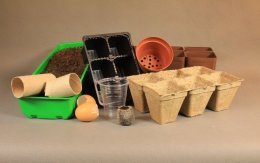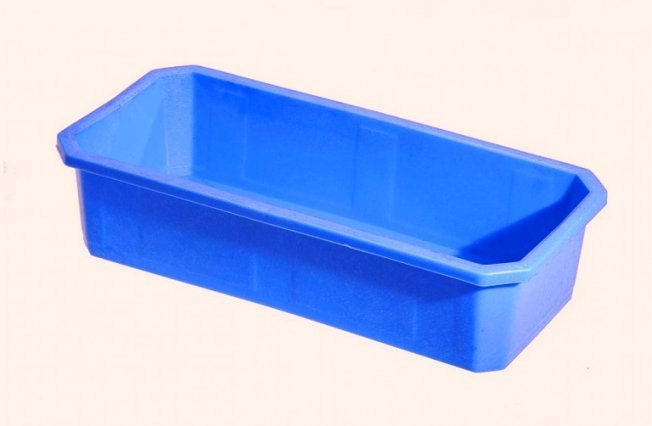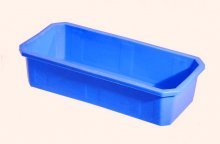How to grow seedlings at home: peat pots or plastic containers?

Growing seedlings is not a very difficult matter, but it requires knowledge of how to prepare the soil, choose seeds, and what containers to sow in. The question of how to grow seedlings at home arises quite often, so we will consider all types of containers made of different materials and determine the most practical container options.
Content:
- Boxes
- Peat pots for seedlings
- Plastic cups and cassettes
- Plastic pots
- We make containers with our own hands
Boxes
Light plastic boxes are usually supplied to retail chains. But in specialized gardening stores you can find wooden containers for sowing seeds. The advantage of boxes made of any material is that it is easy to select products of the required dimensions that correspond to the size of the window sills or shelves.
The boxes simplify the process of caring for seedlings: everything is in one container, and you need to control soil moisture at one point. Changing the location of the seedlings will not be a problem - it is easy to turn it with its back side towards the sun and move it to another window.
The service life of the boxes is long, provided they are treated with care.
The depth of the box should be from 8 to 10 cm; when choosing a box, do not forget that the seedlings will need to dive, then replant into the ground, damage to the roots should be minimal. Plants should be positioned so that the roots do not intertwine during growth.
It is not recommended to use boxes for eggplant and pepper seedlings. These crops have a tap root system and do not respond well to picking.
Since plastic boxes are available in different models in stores, it is easy to choose the ones that are suitable for your windows.
They are not expensive and their weight is light.
Among the disadvantages it should be noted:
- lack of drainage holes in some models, i.e. they will need to be done with a hot nail;
- fragility, the reason for this is that the walls of the containers are too thin.
It’s easy to make a wooden box with your own hands; if you use high-quality wood, it will last for many years. To prevent the box from leaking, the bottom is lined with film, and a tray is placed under the box to drain water.
A wooden product is much stronger than a plastic one and will last longer. But, due to the lack of water flow, watering will need to be done carefully; excess moisture can lead to acidification of the soil and the appearance of putrefactive processes on the roots of plants.
A wooden box filled with soil is heavy and more difficult to move from window to window or transport.
Peat pots for seedlings, tablets and cassettes
Peat products are individual containers for each bush. If you calculate the volumes correctly peat cups, then seedlings can be grown without picking.
Peat tablets are especially popular among amateur vegetable growers. They are pressed peat soaked in a nutrient solution.To maintain their shape, they are covered with non-woven material.
The diameter of the tablets can be different - from 27 mm to 90 mm. Choosing sizes suitable for a particular crop is not at all difficult. Before sowing the seeds, the tablets are soaked, which leads to an increase in their height several times. The seeds are placed in the recesses in the center of the tablet.
For crops whose seedlings are undesirable to be picked, it is better to choose larger tablets; the sprouts obtained in peat discs are picked as they grow.
Among the advantages of peat tablets, we emphasize the following:
- the ability to grow seedlings of any crops;
- air and moisture permeability, which eliminates rotting of the roots;
- there is no need to prepare soil and containers;
- the ability to do without picking;
- before planting in the ground, you only need to remove the non-woven material, the roots will not be damaged;
- the ability to select sizes that are optimal for growing each crop;
- simplification of the picking process (if it is used);
- You can purchase tablets in a container with a lid, i.e. ready-made mini-greenhouse.
Among the disadvantages we point out:
- Drying should not be allowed, because this can cause the death of seedlings, i.e. Humidity control must be constant;
- relatively high cost, if many plants are grown, then the option will be expensive;
- there is no possibility of reuse, because The sprouts are planted in the garden bed along with the tablets.
To make peat pots, a mixture of peat (80%) and paper (20%) is used. The porous structure of the mixture ensures good air and moisture permeability of the cups. There is no need to make drainage holes in them.
The cost of peat pots for seedlings is low; they can be purchased at gardening stores, household supply stores, and even in supermarkets.
An attractive point is that the container is environmentally friendly; during the development period, plants do not accumulate toxic substances harmful to humans. The material of the cups is biodegradable. those. As a result of their use, the environment is not polluted.
Seedlings can be planted in the ground directly with cups, the root system is not damaged, and the plants quickly adapt to the new location.
When using peat pots, you will need to constantly monitor the humidity level - the water from them evaporates quickly. Also, we should not forget that excessive watering can lead to the appearance of mold on the surface of the container. The cups must be handled carefully; they are quite fragile, especially after watering.
In peat pots it is very convenient to grow seedlings of crops that do not tolerate transplantation, in particular: zucchini, cucumbers, and eggplants.
All that can be said about peat cassettes is that they are cups connected together. Among the advantages, one can note the compact placement of containers.
Plastic cups and cassettes
Plastic cups with a capacity of 0.1, 0.2, 0.5 liters, which are widely used in everyday life, can also be used for growing seedlings at home. The largest ones, naturally, are best used for plants that do not like picking.
The price of plastic containers is low, you can buy them in any store. In addition, plastic products can be used for several years.
The disadvantage is the lack of drainage holes, but they are easy to make with a hot awl or nail, or scissors.And light cups filled with soil can easily tip over if not handled carefully, as a result of which the sprouts can be damaged.
Plastic cassettes are the same cups, only connected to each other. Containers can be of different sizes and have 4, 6, 9 cells. It is more convenient to use containers whose height is from 7 to 10 cm.
Cups in cassettes already have drainage holes. When purchasing, you should pay attention to the material of manufacture: polystyrene is considered environmentally friendly; it is better to avoid cassettes made of polyvinyl chloride.
Disadvantages of plastic containers:
- when picking and planting seedlings, problems may arise with
- removing roots from the container;
- it is not recommended to grow crops that have a taproot
- root system (eggplants, sweet peppers).
Plastic pots
In the spring season, they are sold both in specialized stores and in supermarkets. Their shape can be square or round, volume - from 0.05 l to 1 l.
It is easier to remove seedlings from round pots with soft walls, but they take up a lot of space on the windowsill. Square pots are more difficult to extract roots from, but they are more compact.
Among the positive aspects of growing seedlings in plastic pots, the following should be noted:
- low cost of containers;
- possibility of repeated use;
- the ability to grow almost all vegetable crops;
- presence of drainage holes;
- if you sow 1 seed at a time, you can do without picking;
- there is no need for frequent watering, the moisture in such containers
- well preserved.
The disadvantage is the relatively large dimensions; round containers take up a lot of space.
We make containers for seedlings with our own hands
To make homemade containers, you can use available materials that are found in every home:
- eggshells;
- toilet paper rolls;
- egg packaging;
- paper packaging for milk, juice, kefir;
- packages of dairy products;
- plastic bottles.
When using such containers, you will not need to spend money on containers; moreover, it will be possible to give a second life to already used containers, i.e. make your small contribution to the fight against environmental pollution.
Making homemade containers will require some time.
The question of how to grow seedlings at home today is very easy to solve; you can purchase containers of any shape and volume in a retail chain, or make them yourself, the main thing is that they are suitable for the crops whose seedlings you plan to grow.

















